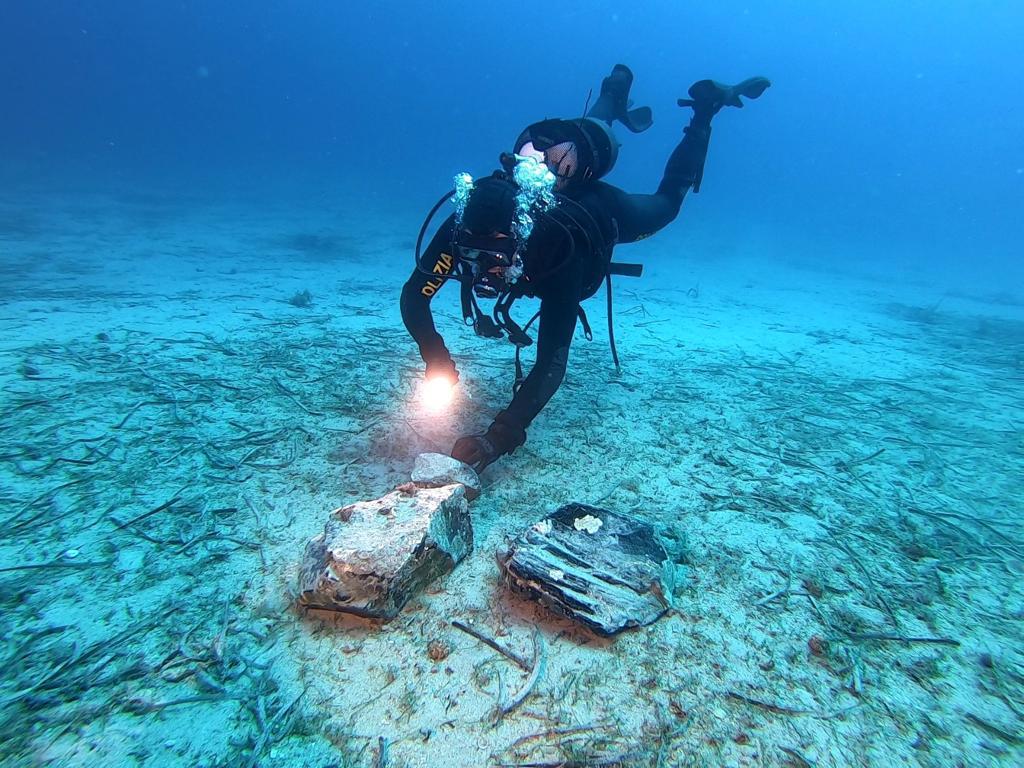The cargo of a Stone Age ship that sank off the coast of Capri in the Bay of Naples has been discovered by a team of underwater archaeologists. Among the scattered freight, the researchers located a large chunk of obsidian, although the identity of the sailors remains a mystery.
Obsidian is a type of volcanic glass (“dragonglass” for GoT fans) that was used in prehistoric times to create blades and other tools. One of the sharpest materials on Earth, the purple-tinted igneous rock occurs naturally on some of Italy’s volcanic islands, although it’s unclear where this particular collection was obtained.
Originally spotted by police divers last month, the Neolithic wreck was later visited by marine scientists from the Superintendency of the Metropolitan Area of Naples. Announcing the discovery, officials explained that the sunken load consisted of a series of worked obsidian cores, one of which shows clear signs of chiseling and carving on its surface.
Remnants of the vessel haven’t been found yet but the large chunks of obsidian cores are very impressive.
Image credit: Superintendency of the Metropolitan Area of Naples
Located at a depth of 30 to 40 meters (98 to 130 feet) below the surface, the large sculpted core measures 28 by 20 by 15 centimeters (11 by 8 by 6 inches) and weighs almost 8 kilograms (17.6 pounds). No traces of the Neolithic vessel that carried the obsidian have been recovered, although Superintendent Mariano Nuzzo said in a statement that archaeologists will now conduct “an extensive instrumental survey of the seabed, to verify the possible presence of the hull or other cargo material.”
The shipwreck was discovered near the famous Grotta Azzurra (Blue Lagoon), a favorite bathing spot of Roman Emperors. Going further back in time, very little is known about human activity on the island of Capri, although there is some evidence that people were present on a number of Mediterranean isles during the Neolithic period.
A large chunk of obsidian, or volcanic glass, which bears traces of chiseling and processing likely by Neolithic people
Image credit: Superintendency of the Metropolitan Area of Naples
For example, obsidian from the island of Melos has been discovered in the Franchthi Cave on the Greek mainland. Located some 80 nautical miles from its source, the material is thought to have been transported across the Aegean Sea by ancient sailors around 13,000 years ago.
Such discoveries provide fascinating insights into the seafaring capabilities of Stone Age humans, although it’s still unclear exactly when we first got our sea legs. Stone tools on the island of Crete, for instance, have been dated to 130,000 years ago and stirred speculation that Neanderthals may have sailed into Europe from the Near East.
Other ancient tools on Melos have been interpreted as evidence for seagoing hominids around half a million years ago, while it’s also believed that our extinct ancestors somehow landed on Flores Island in Indonesia a million years ago.
At present, very little is known about the newly discovered obsidian cores in Italy. However, it’s hoped that upcoming recovery, restoration, and analyses will help to not only reveal the age of the ancient wreck but also fill in some of the gaps in our knowledge of Neolithic Capri.
Source Link: Stone Age Shipwreck Carrying Obsidian Cores Discovered Off Italian Coast
